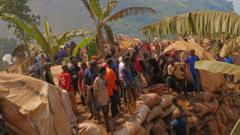Can Rescuers Save Trapped Miners in DR Congo with Bare Hands?

The Tragic Situation of Miners in Eastern Democratic Republic of Congo
The ongoing crisis in the eastern Democratic Republic of Congo (DRC) has drawn international attention as local miners attempt to rescue their trapped comrades using only their bare hands and rudimentary tools. As of now, six miners have been successfully pulled out alive, although one is reported to be seriously injured. The accidents began when shafts collapsed in Lomera, highlighting the dangers of artisanal mining in the region. Conflicting reports regarding the death toll further complicate the situation, with some locals claiming that 12 bodies have been found, while journalists suggest that no bodies have yet been recovered. The chaos surrounding this incident emphasizes the urgent need for better safety measures and oversight in artisanal mining practices in the DRC.
The Background of Artisanal Mining in the DRC
Artisanal mining, often referred to as informal or small-scale mining, has surged in the DRC, particularly in the mineral-rich eastern provinces. The discovery of gold in Lomera has transformed this once-quiet village into a bustling yet chaotic mining hub. Thousands of individuals have flocked to the area, drawn by the prospect of wealth and opportunity. Unfortunately, this has led to a proliferation of unregulated mining activities, where proper safety standards are frequently ignored.
Historically, the DRC has been a hotbed for conflict, with various rebel groups battling for control over the region’s rich mineral resources. The M23 rebel group, which has recently gained significant territory, now controls parts of South Kivu province, where Lomera is located. Their presence adds another layer of complexity to an already dangerous situation, as they often prioritize resource extraction over the safety of miners.
The Rescue Efforts: A Race Against Time
Since the collapse of the mining shafts, local miners and residents have banded together to initiate rescue operations. However, the lack of specialized equipment has severely hampered these efforts. The site remains hazardous, with debris and large stones obstructing access to the trapped miners. Survivors have reported that many individuals remain stuck underground, and the emotional toll on those involved in the rescue is palpable. One miner expressed the exhaustion felt by the rescuers, stating, "We've been digging since Sunday night but have not recovered any bodies. We are exhausted."
The situation is dire, and as rescue operations continue, the need for external support and better equipment becomes more apparent. Many of those attempting to rescue their friends and family members are not trained for such dangerous work, which only increases the risk of additional accidents occurring during the rescue efforts.
Health Risks and Safety Concerns
Aside from the immediate dangers posed by collapsing shafts, there are significant health risks associated with artisanal mining in the DRC. Reports indicate that cholera outbreaks have been a concern in the region, exacerbated by the influx of miners and the lack of proper sanitation. The chaotic nature of these mining operations often leads to unsanitary conditions, posing additional dangers to the health of miners and their families.
Moreover, the environmental impact of unregulated mining can lead to long-term consequences. The destruction of land and contamination of water sources can create a cycle of poverty and health issues for communities reliant on these resources. The lack of regulation means that miners face not only physical dangers but also threats to their overall well-being.
The Role of Rebel Groups and Governance
The M23 rebel group has played a controversial role in the current crisis. Reports indicate that officials from M23 visited the site of the collapse and ordered the cessation of mining activities in certain areas. While this may be a step toward improving safety, the motivations behind such actions are complex. The M23’s interest in controlling resources can lead to further conflict, as they prioritize profits over the safety and welfare of local miners.
Governance and the enforcement of safety regulations are critical in preventing future disasters. The DRC government has struggled to maintain control over the region, allowing rebel groups to fill the power vacuum. The lack of oversight in artisanal mining operations has resulted in a chaotic environment where safety is not prioritized, leading to tragic accidents such as the one in Lomera.
The Global Implications of Artisanal Mining
The minerals extracted from mines in the DRC, including gold, tin, and coltan, are crucial for the global electronics industry. These materials are used in various products, from smartphones to laptops, making the DRC a vital player in the global supply chain. However, the reliance on artisanal mining raises ethical questions regarding the sourcing of these materials.
Consumers and companies alike must consider the conditions under which these minerals are mined. The tragic events in Lomera serve as a stark reminder of the human cost associated with these resources. Increased awareness and pressure for ethical sourcing can lead to better practices and the implementation of safety regulations that can save lives.
Future Considerations for Artisanal Mining in the DRC
The current crisis presents an opportunity for change. It highlights the urgent need for improved safety measures and regulation of artisanal mining in the DRC. Collaborative efforts between the government, international organizations, and local communities are essential in creating a safer mining environment.
Investing in training programs for miners can help educate them on safe mining practices, reducing the risk of accidents. Additionally, the implementation of proper infrastructure and equipment could significantly enhance the safety of mining operations. These changes are crucial not only for the miners’ safety but also for the communities that depend on these resources.
FAQs
What is artisanal mining?
Artisanal mining refers to informal and small-scale mining activities that are often conducted by individuals or small groups using basic tools and methods. It is usually unregulated and can pose significant safety and health risks.
What are the main risks associated with artisanal mining?
The primary risks include physical dangers such as accidents from collapsing shafts, health risks like cholera outbreaks, and environmental concerns from unregulated mining practices.
How does artisanal mining impact the global electronics industry?
Artisanal mining provides essential minerals used in the production of electronics, including gold, tin, and coltan. However, the conditions under which these materials are mined raise ethical concerns regarding labor practices and safety.
What can be done to improve safety in artisanal mining?
Improving safety in artisanal mining can involve better regulation, training for miners on safe practices, and providing access to proper equipment and infrastructure. Collaborative efforts between governments, local communities, and international organizations can also help bring about change.
As the situation in Lomera continues to unfold, it remains imperative to reflect on the broader implications of artisanal mining in the DRC and the human cost associated with it. The tragic incident serves as a wake-up call for all stakeholders involved in the mining industry. How can we work together to ensure the safety and well-being of miners while still addressing the global demand for these vital resources? #ArtisanalMining #DRC #MiningSafety
Published: 2025-07-22 15:09:03 | Category: world



